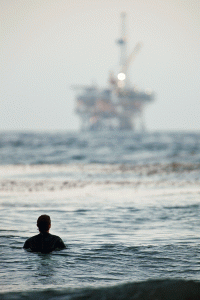Groups File Lawsuit Challenging Federal Approval of Offshore Fracking and Acidizing
November 11, 2016
Lawsuit Seeks Protection of Endangered Species and Full Environmental Review
SANTA BARBARA—The Environmental Defense Center (“EDC”) and Santa Barbara Channelkeeper filed a lawsuit today, challenging the failure of the federal government to analyze and disclose the potential risks and impacts caused by fracking and acidizing from offshore oil platforms in southern California, including the Santa Barbara Channel. The lawsuit alleges that the Bureau of Ocean Energy Management (“BOEM”) and Bureau of Safety and Environmental Enforcement (“BSEE”) violated the federal Endangered Species Act (“ESA”) because they failed to consult with the expert wildlife agencies regarding potential impacts from these well stimulation techniques to at least 25 threatened and endangered species, including whales, sea otters, fur seals, sea turtles, marine and coastal birds, fish, and abalone.

Platform Holly. Photo by Erin Feinblatt.
The lawsuit also seeks to compel the agencies to prepare an Environmental Impact Statement (“EIS”) under the National Environmental Policy Act (“NEPA”) that will fully evaluate and disclose the potential impacts on the marine environment, including toxic discharges of frac flowback fluid and extending the life of the existing oil platforms.
“We are disappointed that the federal government continues to fail to take a hard look at the impacts of offshore well stimulation which poses a tremendous threat to the local environment,” said Maggie Hall, Staff Attorney with EDC. “The agencies’ own analysis identifies numerous threats to the environment, including exposure of local wildlife to toxic chemicals in frac flowback, collisions with vessels delivering chemicals to offshore platforms, and harm caused by the heightened risk of oil spills, among other concerns.”
“The impacts of offshore fracking and acidizing have never been meaningfully analyzed,” said Kira Redmond, Executive Director of Channelkeeper. “These practices will extend the life of existing oil platforms in a sensitive marine environment, which is still recovering from the May 19, 2015 Plains All American Pipeline rupture that devastated California’s coastline. We need information to understand the potential impacts of these practices so that appropriate measures can be implemented to protect the diverse web of marine life off our coast.”
In August, the groups sent BOEM and BSEE a notice of their intention to sue if the agencies failed to consult with the Fish and Wildlife Service and National Marine Fisheries Service, as required under the ESA. Through formal consultation, these agencies would prepare a “biological opinion” and impose safeguards to ensure that wildlife and their habitat are not harmed. BOEM and BSEE failed to respond to the notice or initiate consultation, so EDC and Channelkeeper now seek judicial intervention.
The Santa Barbara Channel harbors such incredible biological diversity that it has been dubbed the “Galapagos of North America.” The following threatened and endangered species depend on the local environment for their survival and recovery, and are at risk from fracking and acidizing practices offshore:
- Marine mammals: sei whale, blue whale, fin whale, North Pacific right whale, humpback whale, sperm whale, Guadalupe fur seal, southern sea otter
- Benthic organisms: black abalone, white abalone
- Fish: southern California steelhead, scalloped hammerhead shark, southern green sturgeon, tidewater goby
- Birds: the light-footed Ridgway’s rail, western snowy plover (Pacific DPS), marbled murrelet, California least tern, short-tailed albatross, Hawaiian petrel, California Ridgway’s rail
- Sea Turtes: loggerhead turtle (North Pacific ocean DPS), the leatherback turtle, the green turtle, and the olive ridley turtle.
EDC previously sued BOEM and BSEE after learning that the agencies had approved more than 50 permits allowing offshore well stimulation, including fracking and acidizing, without any environmental review. That lawsuit led to a settlement agreement requiring the agencies to prepare the first ever environmental review of offshore fracking and acidizing. Unfortunately, the resulting analysis failed to meaningfully address the potential impacts to the marine environment.
Specifically, the agencies failed to adequately analyze the impacts of offshore well stimulation on air quality, water quality, the Channel Islands National Marine Sanctuary, geologic resources/seismicity, benthic resources, marine and coastal birds, marine mammals, sea turtles, commercial and recreational fisheries, recreation and tourism, environmental justice, and archaeological resources. The assessment also suffered from missing information and numerous data gaps, including the toxicity and impacts of chemicals utilized in the process.
Acidizing and fracking are both potentially dangerous oil production processes involving the injection of large amounts of water and chemicals into the ground in order to fracture or dissolve rock. In both processes, many chemicals remain undisclosed under “trade secret” laws, but are known to pose risks at all stages of use, from transportation to and from the platforms, to disposal of such chemicals through underground injection or direct discharge to the ocean. More information can be found in EDC’s Dirty Water: Fracking Offshore California report.
###
The Environmental Defense Center, a non-profit law firm, protects and enhances the local environment through education, advocacy, and legal action and works primarily within Ventura, Santa Barbara, and San Luis Obispo counties. Since 1977, EDC has empowered community-based organizations to advance environmental protection. EDC’s focus areas include protection of the Santa Barbara Channel, ensuring clean water, preserving open space and wildlife, and addressing climate and energy. Learn more about EDC at www.EnvironmentalDefenseCenter.org.
Santa Barbara Channelkeeper is a grassroots non-profit organization dedicated to protecting and restoring the Santa Barbara Channel and its watersheds through science-based advocacy, education, field work and enforcement. Learn more about Channelkeeper at www.sbck.org.





